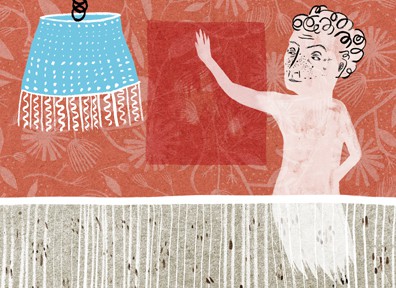STORY BY Marion Winik
In case you think your mother’s death is going to put a stop to her always being right about everything and your coming up always just short of the mark, I draw your attention to the Case of the Missing Calder. During the nine months that my mother had lung cancer in 2008 and 2009, my sister Nancy and I spent as much time as we had since we were kids in our childhood home, a ranch house in a 50-year-old development in Monmouth County, NJ. It was an hour and a half for Nancy from Suffern and three hours for me from Glen Rock, PA, but we came as often as we could. It was surely one of my mother’s last pleasures – as golf, bridge, theater, books and, finally, even her evening date with the television show “Jeopardy” were taken from her – to see the two of us mutate into The Winik Girls again.
As Nancy and I took turns at doctors’ appointments, in the hospital and at her bedside, our mother gradually handed over to us not just medical and household decisions but management of the intricate, ruthlessly organized empire we referred to as Jane Winik, Incorporated. My certified public accountant sister was appointed treasurer and I, the writer, became secretary. Actually, the division of labor occurred after my approach to recording payments and deposits was deemed inadequate. (What kind of obsessive maniac writes the check number on the bill and the bill number on the check and keeps all kinds of totals? Are we running a multi-national corporation or paying the plumber? My sister took the ledger out of my hands.)
In general and as always, both of us were killing ourselves to please our mother and we mostly succeeded, but there were a few things she didn’t quite trust us on, and it turned out she was right.
Even before the days of turning over safe deposit box keys and signing powers of attorney, my mother feared that my sister and I did not fully appreciate the value of the small collection of artist’s prints and oil paintings she and my late father had acquired. For one thing, she knew that this art was not to either of our tastes. There was the depressing modernist cityscape, the twirling, Impastoed tango dancers, the “cubist” snow-roofed barn, the obligatory Don Quixote in the powder room. But, she would point out, the Vasarely certainly is worth something! And the Calder!
My mother’s Alexander Calder print, which hung in a place of honor in the living room under its own art lamp, was (as my sister recited from the authentication) a red, blue and yellow abstract lithograph titled “Caracol,” #65 of 75, bought by my parents in 1980.
On the day of the home sale at which we hoped to sell my mother’s remaining furniture and possessions (we’d already given 37 bags of perfectly kept, size 6-petite suits, dresses and golf attire to Jewish Child and Family Services), both it and the Vasarely were stowed in my old bedroom with other items not for sale. While we’d stuck hopeful price tags on a few of the items, we were still too upset by the prospect of hawking the contents of our childhood home to strangers to do all the organizing and sorting we should have. My mother would have had plenty of criticism of this haphazard event, and as it turned out she would have been right.
The sale was to begin at 9 on a Saturday morning, and neither my sister nor I made it there in time. When the real estate agent who was selling the house for us got there at 8:30, there were a dozen people waiting and when he unlocked the door they poured in in a frenzy. By the time I arrived at 10:30, my sister was on the front lawn with one of my mother’s lifelong best friends, discussing the theft of the entire set of my grandmother’s silver flatware. (It was in the drawer of a highboy, also not for sale.) I walked in, went straight to the back bedroom and found that the Calder was also missing.
The rest of the day was a blur. The poor flummoxed real estate agent thought he might have sold a painting tagged at $5 to a blonde lady who worked at Home Depot – he had only seen it from the rear, while conducting another transaction. However, when we tracked her down, the blonde lady assured us she had purchased the Toulouse-Lautrec knock-off and there had been no Calder in the house by the time she got there. She surely would have known. Meanwhile, she asked, were we definitely not interested in selling the Vasarely?
By this time we loved the obnoxious op art Vasarely as much as anything we’d ever seen and would no more part with it than we would our own children.
By the end of the day, rehashing the mysterious thefts over and over with the New Jersey home sale habitués, we found ourselves enmeshed in a sort of Agatha Christie-meets-Danny De Vito scenario. We interrogated helpful neighbors picking through a tray of earrings; a handsome, graying junk dealer hauling out the living room set; while a ridiculously young cop scribbled on a note pad. Everybody had a different opinion, another line of speculation. Meanwhile my mother’s size 6-petite ghost floated in the background, stroking the discolored rectangle on the wood panelling where the Calder had once hung, beneath the disconnected art lamp.
By that time, there had been so many changes in the world that would have upset my mother since her death the previous April. Some of it was the fault of Wall Street, some the government, but some of it, Nancy and I knew, was ours. Of course she would have forgiven us – our mother couldn’t hold a grudge long enough to smoke two cigarettes – but it’s different when you have to imagine your own pardon. Screwing up just isn’t what it used to be, when there’s no one to be furious at you and no one to gradually soften.
Somewhere, I know, she was very proud of us, when we followed up with her homeowner’s insurance agency and recorded the deposit of the claim check – in triplicate.




